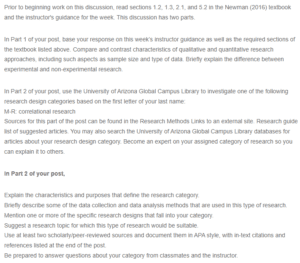Correlational, Qualitative, and Quantitative Research
Part 1: Qualitative and Quantitative Research
Qualitative research is the type of research that focuses on attitudes, opinions, and motivations to understand the underlying reasons around a phenomenon. The study seeks to answer the questions of “how,” “why,” and “when” of the phenomena and findings presented in wording. Data in a qualitative study can be structured or unstructured, as Newman (2016) suggests. Such data is obtained using qualitative data collection methods such as interviews, focus groups, and key informants. Qualitative research employs smaller samples compared to quantitative research. Contrarily, quantitative research is a type of research that investigates a phenomenon by collecting and analyzing numerical data and relevant statistics. Quantitative research relies on measurable data to deduct facts and patterns related to phenomena under study. Data in quantitative research is mainly structured and collected through methods such as observation and questionnaires. Large samples are used.
Essentially, experimental and non-experimental research differ based on whether the control variable is manipulated or not (Newman, 2016). Experimental research entails an experiment whereby a scientific approach is employed, and one or more explanatory variables are controlled to determine their effects on the response variables. The placebo group is controlled in a lab situation. On the other hand, non-experimental research is a research design that does not involve manipulating the control variables. The research is not conducted experimentally but employs observation, case studies, and survey methods.
Part 2: Correlational Research
Correlational research is a non-experimental research approach that aims to understand the statistical relationship between two factors of interest, controlling for influence from confounding factors (Buhse et al., 2018). Therefore, the research characteristics include being non-experimental, using historical data, and acknowledging dynamism in the relationship between factors. Data collection methods are major methods that do not allow for data manipulation, such as naturalistic observation, survey, and archival research. Quantitative data analysis techniques are mainly used. One research design under the research approach is correlation analysis. A research topic that can be investigated under correlational research is the relationship between income and education levels in a particular population.
References
Buhse, S., Rahn, A. C., Bock, M., & Mühlhauser, I. (2018). Causal interpretation of correlational studies: Analysis of medical news on the official journal for German physicians website. PLoS ONE 13(5): e0196833. https://doi.org/10.1371/journal.pone.0196833
Newman, M. (2016). Research methods in psychology (2nd ed.). San Diego, CA: Bridgepoint Education, Inc.
ORDER A PLAGIARISM-FREE PAPER HERE
We’ll write everything from scratch
Question
Prior to beginning work on this discussion, read sections 1.2, 1.3, 2.1, and 5.2 in the Newman (2016) textbook and the instructor’s guidance for the week. This discussion has two parts.

Correlational, Qualitative, and Quantitative Research
In Part 1 of your post, base your response on this week’s instructor guidance as well as the required sections of the textbook listed above. Compare and contrast characteristics of qualitative and quantitative research approaches, including such aspects as sample size and type of data. Briefly explain the difference between experimental and non-experimental research.
In Part 2 of your post, use the University of Arizona Global Campus Library to investigate one of the following research design categories based on the first letter of your last name:
M-R: correlational research
Sources for this part of the post can be found in the Research Methods Links to an external site. Research guide list of suggested articles. You may also search the University of Arizona Global Campus Library databases for articles about your research design category. Become an expert on your assigned category of research so you can explain it to others.
In Part 2 of your post,
Explain the characteristics and purposes that define the research category.
Briefly describe some of the data collection and data analysis methods that are used in this type of research.
Mention one or more of the specific research designs that fall into your category.
Suggest a research topic for which this type of research would be suitable.
Use at least two scholarly/peer-reviewed sources and document them in APA style, with in-text citations and references listed at the end of the post.
Be prepared to answer questions about your category from classmates and the instructor.


